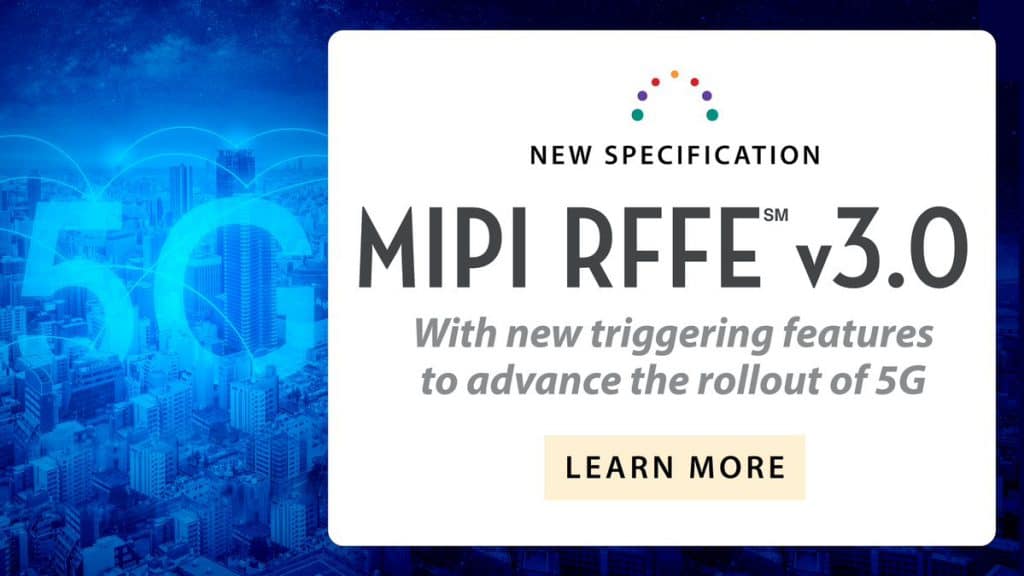
Features in v3.0 bring significant new capabilities to the well-established MIPI specification. Since its initial release a decade ago, RFFE has been deployed in billions of devices—in virtually every device with cellular connectivity—including handsets, smartwatches and automobiles, to name a few.
“The new version of the specification expands its applicability to 5G use cases beyond mobile, such as for automotive, industrial and the Internet of Things (IoT),” said Joel Huloux, chairman of MIPI Alliance. “Development of MIPI RFFE v3.0 was laser focused on satisfying the unprecedented requirements for tight timing precision and low latency in the 3GPP 5G standard today. In this way, the specification helps ensure that manufacturers’ 5G devices deliver the high-performance RF capabilities necessary to enable critical consumer and business features in emerging 5G application spaces.”
MIPI RFFE simplifies the design, configuration and integration of the increasingly complex RF front end—which encompasses the power amplifiers, antenna tuners, filters, low-noise amplifiers (LNAs) and switches—connecting with the modem baseband and/or RF integrated circuit (RFIC) transceiver. As the number of RF bands involved in both uplink and downlink communications has exploded in the rollout of 5G, the subcarrier spacing (SCS) windows among RF packets have narrowed. MIPI RFFE v3.0 addresses the decreased reconfiguration windows and lower-latency switching among various bands and band combinations demanded in the 3GPP 5G standard by delivering enhanced triggering features and functionality, which results in fast, agile, semi-automated and comprehensive control of individual RFFE subsystems.
MIPI RFFE v3.0 utilizes multiple, complementary triggers to synchronize and schedule changes in register settings, either within a slave device or across multiple devices:
- Timed triggers—Allows for tighter, synchronized timing control of multiple carrier aggregation configurations
- Mappable triggers—Enables groups of control functions to be remapped to other triggers quickly and easily
- Extended triggers—Boosts the number of unique triggers available in the RF control system and accommodates increasingly complex radio architectures
With the enhanced triggering functions, MIPI RFFE v3.0 improves throughput efficiencies and reduces packet latency, while also improving the precision in trigger placement. For back-to-back triggering operations, for example, the specification delivers a 20x improvement in timing precision.
Because MIPI RFFE v3.0 is backward compatible with prior generations of the specification, original equipment manufacturers and device vendors can migrate to 5G systems more quickly and easily, without changes to the physical layer of the control interface. The RFFE specification was initially released in 2010 and has seen numerous revisions since that time. Each release has provided additional functionality for developers to aid in the demand for newer RF front-end features.
“With MIPI RFFE v3.0, the specification has been streamlined and optimized to deliver the specific capabilities required to thrive in today’s 5G rollout across the Frequency Range 1 (FR1) of traditional sub-6 GHz cellular bands,” said Jim Ross, MIPI RF Front End Control Working Group Chair. “The working group is always looking to refine the specification to continue differentiating and benefitting our user community, and we welcome engagement in requirements gathering for Frequency Range 2 (FR2) and the ongoing evolution of the next-generation MIPI RFFE for the subsequent stages of 5G deployment.”
MIPI has scheduled a webinar, “A New MIPI RFFE for the Emerging 5G Era,” on June 2, 2020, at 11 am EDT, 8 am PDT, to further explore the features and benefits of MIPI RFFE v3.0 and provide an update on the RFFE ecosyst